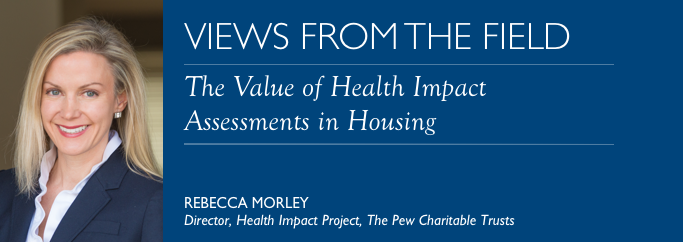
Although many of the links between unsafe housing conditions and health—such as lead paint, mold, and rodents—are well-known, there are other, less obvious, connections between the places people live and their health. Housing affordability, location, and the composition of social and economic conditions of communities are also directly and indirectly linked to health. The Health Impact Project, a collaboration of the Robert Wood Johnson Foundation and The Pew Charitable Trusts, worked with the National Center for Healthy Housing and the National Housing Conference to develop A Systematic Review of Health Impact Assessments on Housing Decisions and Guidance for Future Practice, a roadmap for housing and public health professionals for integrating health considerations into housing decisions. Drawing on this guidance, the Health Impact Project issued two briefs in March on housing and health impact assessments (HIAs), which are a powerful tool to ensure that health is considered in decisions that shape the places people live, work, and play. One brief is for public health professionals and the other for housing professionals.
The guidance document examines the link between housing and health in four key areas: quality, affordability, location, and housing community.
Quality
Quality is about the physical structure, operation, and maintenance of a property. Extensive research shows the link between poor housing quality and health. Living in substandard housing can result in injuries, asthma, cancer, poor mental health, and even death. One HIA that explored this facet of housing and health was the Massachusetts Low Income Energy Assistance Program.
The HIA studied the health risks—such as burns and carbon monoxide poisoning—that can result when families turn to unsafe heating sources because their high energy bills force them to choose between paying to stay warm and buying food. The assessment also identified the unhealthy living conditions faced by families that were not able to afford adequate housing because of high energy costs. These conditions include exposure to pests, water leaks, mold, and peeling lead paint—all of which can lead to asthma, injuries, lead poisoning, and other health hazards. Recommendations included:
- Fully funding the federal Low-Income Home Energy Assistance Program (LIHEAP) at the maximum authorized level.
- Increasing LIHEAP benefit levels for vulnerable families by allocating state supplementary funds.
- Extending outreach services to clinicians in health care settings.
- Creating an initiative that addresses the needs of families on LIHEAP waiting lists.
- Enforcing required data collection on arrearages and disconnections by utility companies.
- Exploring the rise of the home energy insecurity scale.
The HIA helped increase the level of funding for the LIHEAP program in Massachusetts.
Affordability
A lack of affordable housing affects people’s ability to acquire and maintain adequate shelter, and also limits their capacity to meet other basic needs. Therefore, it is important to ensure adequate housing for people at all income levels. Financial constraints can force families to choose between paying for rent, utilities, food, or medical care, which can result in food insecurity, housing instability, chronic stress, and related physical health problems.
The Farmers Field Rapid HIA examined the health impacts of a proposed stadium in Los Angeles on residents at risk of displacement during and after construction. The HIA considered the ways in which gentrification, displacement, housing costs, policing and safety, access to open spaces, and employment opportunities would change under the proposed development, and how these changes could affect low-income and vulnerable populations. The HIA included substantial guidance and comments from residents living in the neighborhoods that would be affected. Recommendations included:
- Compensation to any resident who is displaced or forced to move as a result of the stadium’s construction or operation.
- Inclusion in the project design of open and green space immediately outside of the stadium.
- Development of a local hiring agreement for area residents for any jobs created.
According to a community organizer at the Los Angeles Community Action Network, the HIA process helped educate and engage the community surrounding the proposed project site and spurred inclusion of the following provisions in the development plan if the property is approved for construction:
- Creating a $15 million housing trust fund to preserve and create very low-income housing in neighborhoods affected by the construction.
- Including $1.9 million for air quality and bus rider improvements and development of neighborhood improvement plans.
- Requiring that the city’s living wage be the minimum for all on-site jobs.
- Establishing that 40 percent of all local hires in permanent jobs will be prioritized for disadvantaged workers.
Location
Location pertains to the physical environment near a home, such as access to health services; condition of streets and nearby buildings; distance from air pollution, noise, and traffic; and access to employment opportunities and public transportation. Easy access to public transportation, parks and recreation, quality schools, good jobs, healthy food, and medical care can help reduce the incidence of respiratory and other chronic diseases, injury, mortality, and poor mental health. Vulnerable populations, including those with existing health challenges, are more likely to be affected, negatively or positively, by factors related to housing location.
The Legal Aid Foundation of Los Angeles, Housing Long Beach, and Human Impact Partners conducted the Long Beach Housing Element HIA on the update to the housing section of Long Beach’s general plan. California requires this update every eight years. The HIA made a number of recommendations related to housing location, including:
- The city of Long Beach should collaborate with community stakeholders when identifying proposed residential sites.
- Sites should have access to public transit, recreational facilities, and fresh fruit and vegetables.
Housing Community
Neighborhoods affect the health of adults and children through a number of mechanisms, including racial, ethnic, and class diversity; residential stability; employment rates; and social relationships and supports.
The Atlanta Beltline HIA focused on the planning process for the Atlanta Beltline—a major public transit, trails, parks, and urban-redevelopment project—and addressed a wide range of health issues, including opportunities for physical activity and social connections, safety, access to healthy food, and air and water quality and other environmental concerns. According to the HIA, the project can improve social capital—the people, services, and networks that strengthen communities—by preserving neighborhoods, creating places for formal and informal social interactions, and, most directly, embracing an inclusive public participation process. The recommendations included:
- Developing a mechanism when setting budget priorities that takes into account health impacts throughout the project.
- Appointing public health experts to decision making bodies.
- Establishing policies and programs to prevent displacement in areas surrounding the BeltLine Tax Allocation District.
- Accelerating the implementation schedule so that the much-needed health benefits of the Beltline would be realized sooner.
Partly because of the HIA, health has become a top priority for the Atlanta Beltline through a Decision-Support Tool, board appointments, and the mayor’s commitment to construct the BeltLine 10 years ahead of schedule. The HIA also helped secure a $1 million grant from the U.S. Environmental Protection Agency to clean up abandoned industrial sites along the corridor and speed the development process.
The Health Impact Project conducted one federal-level HIA and provided grants to support more than 100 others across the country, including some in the housing sector. HIAs can help the public health and housing sectors build strong partnerships that leverage their unique assets and reach their shared goal of improving community health and quality of life.
Resources
National Center for Healthy Housing. “A Systematic Review of Health Impact Assessments on Housing Decisions and Guidance for Future Practice.” March 2016. https://www.nchh.org/Portals/0/Contents/Guidance-for-Conducting-HIAs-on-Housing-Decisions.pdf
The Pew Charitable Trust Foundation. “Guidance for Housing Professionals: Health impact assessment and housing.” March 24, 2016. https://www.pewtrusts.org/en/research-and-analysis/issue-briefs/2016/03/guidance-for-housing-professionals
The Pew Charitable Trust Foundation. “Guidance for the Public Health Sector: Health impact assessment and housing.” March 24, 2016. https://www.pewtrusts.org/en/research-and-analysis/issue-briefs/2016/03/guidance-for-the-public-health-sector

